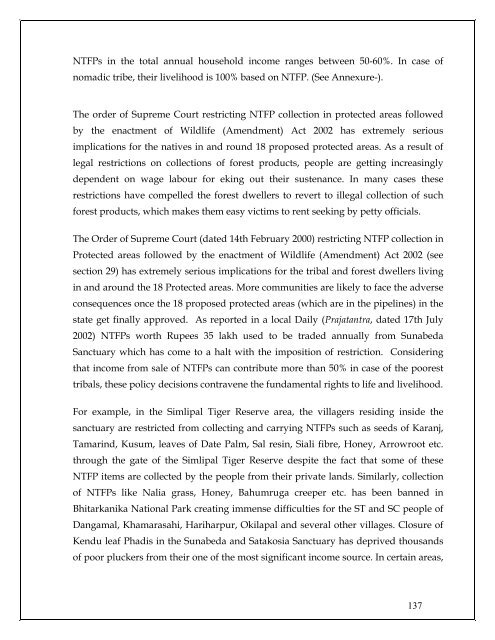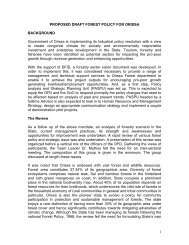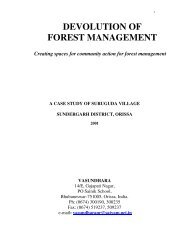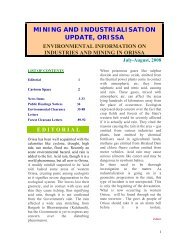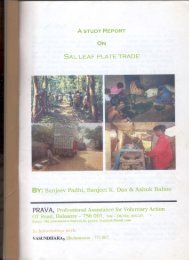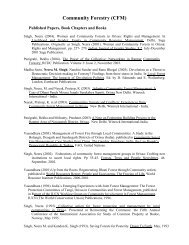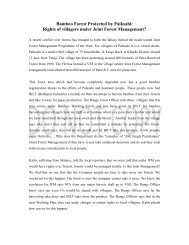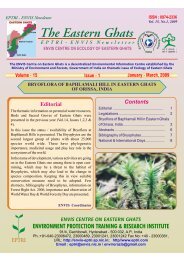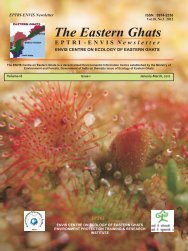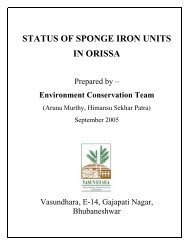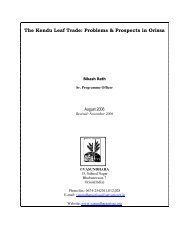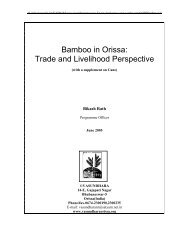Protected Area Network in Orissa - Vasundhara
Protected Area Network in Orissa - Vasundhara
Protected Area Network in Orissa - Vasundhara
- No tags were found...
You also want an ePaper? Increase the reach of your titles
YUMPU automatically turns print PDFs into web optimized ePapers that Google loves.
NTFPs <strong>in</strong> the total annual household <strong>in</strong>come ranges between 50-60%. In case ofnomadic tribe, their livelihood is 100% based on NTFP. (See Annexure-).The order of Supreme Court restrict<strong>in</strong>g NTFP collection <strong>in</strong> protected areas followedby the enactment of Wildlife (Amendment) Act 2002 has extremely seriousimplications for the natives <strong>in</strong> and round 18 proposed protected areas. As a result oflegal restrictions on collections of forest products, people are gett<strong>in</strong>g <strong>in</strong>creas<strong>in</strong>glydependent on wage labour for ek<strong>in</strong>g out their sustenance. In many cases theserestrictions have compelled the forest dwellers to revert to illegal collection of suchforest products, which makes them easy victims to rent seek<strong>in</strong>g by petty officials.The Order of Supreme Court (dated 14th February 2000) restrict<strong>in</strong>g NTFP collection <strong>in</strong><strong>Protected</strong> areas followed by the enactment of Wildlife (Amendment) Act 2002 (seesection 29) has extremely serious implications for the tribal and forest dwellers liv<strong>in</strong>g<strong>in</strong> and around the 18 <strong>Protected</strong> areas. More communities are likely to face the adverseconsequences once the 18 proposed protected areas (which are <strong>in</strong> the pipel<strong>in</strong>es) <strong>in</strong> thestate get f<strong>in</strong>ally approved. As reported <strong>in</strong> a local Daily (Prajatantra, dated 17th July2002) NTFPs worth Rupees 35 lakh used to be traded annually from SunabedaSanctuary which has come to a halt with the imposition of restriction. Consider<strong>in</strong>gthat <strong>in</strong>come from sale of NTFPs can contribute more than 50% <strong>in</strong> case of the pooresttribals, these policy decisions contravene the fundamental rights to life and livelihood.For example, <strong>in</strong> the Simlipal Tiger Reserve area, the villagers resid<strong>in</strong>g <strong>in</strong>side thesanctuary are restricted from collect<strong>in</strong>g and carry<strong>in</strong>g NTFPs such as seeds of Karanj,Tamar<strong>in</strong>d, Kusum, leaves of Date Palm, Sal res<strong>in</strong>, Siali fibre, Honey, Arrowroot etc.through the gate of the Simlipal Tiger Reserve despite the fact that some of theseNTFP items are collected by the people from their private lands. Similarly, collectionof NTFPs like Nalia grass, Honey, Bahumruga creeper etc. has been banned <strong>in</strong>Bhitarkanika National Park creat<strong>in</strong>g immense difficulties for the ST and SC people ofDangamal, Khamarasahi, Hariharpur, Okilapal and several other villages. Closure ofKendu leaf Phadis <strong>in</strong> the Sunabeda and Satakosia Sanctuary has deprived thousandsof poor pluckers from their one of the most significant <strong>in</strong>come source. In certa<strong>in</strong> areas,137


